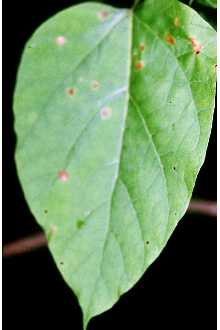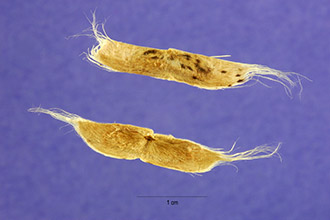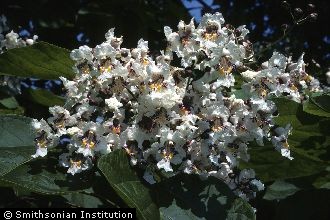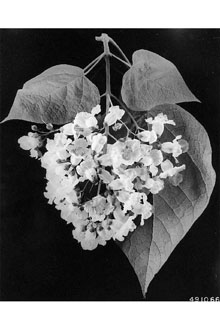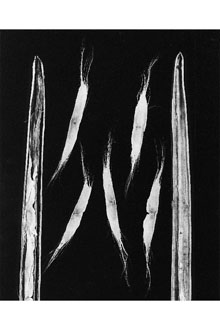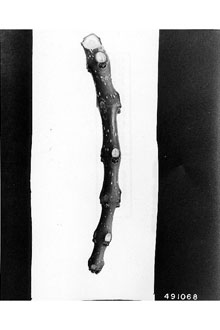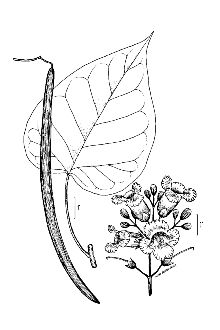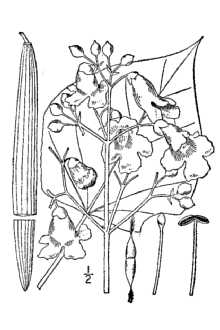Southern Catalpa
Scientific Name: Catalpa bignonioides Walter
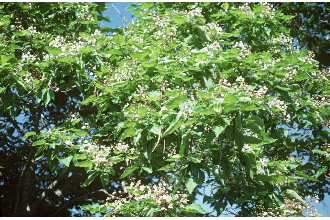
| General Information | |
|---|---|
| Usda Symbol | CABI8 |
| Group | Dicot |
| Life Cycle | Perennial |
| Growth Habits | Tree |
| Native Locations | CABI8 |
Plant Guide
Alternate Names
Catalpa, katalpa, American catalpa, common catalpa, eastern catalpa, catawba, bean tree, Indian bean, Indian cigar tree, lady cigar, Shawnee wood, caterpillar tree, worm tree, fish bait tree, fisherman’s tree (Little 1979; Anonymous 2005). Catalpa is an old American Indian name for the plant. Warning!! The roots of this species are highly poisonous (Chevallier 1996).
Uses
Industry: Used for general construction work, interior finish, cabinetwork, fence posts, rails, and fuel (Stephens 1973). Ornamental: Southern catalpa is primarily used today as a large ornamental shade tree. It is widely planted in urban areas as a street and lawn tree. When flowering it has abundant showy blossoms (Pack 1952). Ethnobotanic: In some of the older medical journals (19th century) there were speculations that catalpa gave off poisonous emanations. However, there is no scientific evidence to prove those speculations (Bailey 1939). Pioneer doctors used the seed pods and seeds to make a decoction for chronic bronchial affection, spasmodic asthma, labored breathing, and heart problems. The juice from either the leaves or roots was used to treat swelling of an eye or cutaneous affections. Green leaves were crushed and placed on swollen lymph glands. The bark was dried then ground to a powder and taken, or brewed in a tea and taken for swollen lymph glands (Dalby 1999). A tea made from the bark has been used as an antiseptic, snake bite antidote, laxative, sedative and vermifuge. This tea was also used as a substitute for quinine in treating malaria. A tea made from the seeds was used in the treatment of asthma and bronchitis as well as used as a rinse on wounds. In addition to having a sedative effect, the plant also is reported to have a mild narcotic action. It was therefore used in preparations with other herbs for the treatment of whooping cough, asthma and spasmodic coughs in children (Felter and Lloyd 1989). Pods and seeds have been reported to possess antispasmodic, cardiac, and sedative properties. The bark is said to have been an anthelmintic alternative. Modern pharmaceutical research has shown catalpa trees have diuretic properties. R. Alan Shadow, NRCS, East Texas Plant Materials Center Conservation: Planted in windbreaks and on mined land reclamation projects. Some plant it to attract the catalpa worm, which are harvested and used as fish bait.
Status
Please consult the PLANTS Web site and your State Department of Natural Resources for this plant’s current status (e.g. threatened or endangered species, state noxious status, and wetland indicator values).
Weediness
This plant may become weedy or invasive in some regions or habitats and may displace desirable vegetation if not properly managed, Please consult with your local NRCS Field Office, Cooperative Extension Service office, or state natural resource or agriculture department regarding its status and use, Weed information is also available from the PLANTS Web site at plants,usda, Use soil moisture sensors to measure the soil moisture of Southern Catalpa.,gov,
Description and Adaptation
Adaptation
Adaptation
General: Trumpet-creeper Family (Bignoniaceae). It is a perennial deciduous tree which readily grows in USDA Hardiness Zones 5 to 9. This is a U.S. native (Geyer 2000; Little 1979). At maturity, the height can vary from about 25 to 40 feet. The crown is often forked. Its longevity is about 40 to 50 years. The National Registry of Big Trees (Anonymous 2008) reports a specimen in Mississippi that is 88 feet tall with a circumference of 271 inches. The tree bark is separated into irregular shallow fissures with reddish-brown scales. On young tree seedlings the bark is thin and easily damaged by impact, or rodents. Twigs in winter have a unique identifying characteristic. They have sunken leaf scars which resemble suction cups. Their whorled arrangement of 3 “moon crater” scars per node is another trait easily identified. They are grayish-brown in color. Buds are small, red-brown, wider than long, and slightly hairy (Stephens 1973). Leaves are simple, may be opposite or whorled (3 per node), pinnately veined, 5 to 12 inches long, 4 to 6 inches broad, heart shaped at the base, and have a long petiole with entire margins and soft pubescence on the underside, which is also a lighter green than the top surface (Harlow 1979). Flowering and Fruiting: The flowers of catalpa are perfect. Flowering takes place from May through July. They occur in bell-shaped corollas of 5 lobes. Individual flowers are showy, with the 5 petals in each flower being unequal in size, white with purple spots and orange stripes at the throat, in branched, upright clusters. The petals are up to 1.5 inches long. Seedpods are slender and green in the summer growing from 6 to 24 inches long, and ½ inch wide looking ‘cigar like’. They mature in the autumn, turn brown, split open lengthwise to let seeds fall in the spring. The seedpod generally stays attached to the tree limb over winter. Southern catalpa seeds are drawn out more to a point while the northern catalpa seeds are blunter at the end. Seeds are about 1 inch long and 1/3 inch wide. They have a light brown coat and wings rounded at the ends terminating in a fringe of short hairs. There are approximately 20,480 seeds per pound (USDA 1948). Wood characteristics: The wood is of moderately light density (specific gravity 0.42 oven dry), with pale gray sapwood and grayish brown heartwood. It has a faint, aromatic, non characteristic odor and no characteristic taste. It is ring porous, coarse-grained, soft, not strong, but very durable in contact with the soil (Pansion and de Zeeuw 1980). Distribution: Originally found in the Gulf Coast states of Florida, Georgia, Alabama, Mississippi and Louisiana, it was first cultivated in 1726. It has since spread to many states east of the Rocky Mountains, the southwestern states, and Oregon (USDA 1948). Habitat: Southern catalpa is native to Alabama, Georgia, Florida, and Mississippi. It is widely naturalized from New England and New York to Ohio and the central and southern plains states. Catalpas prefer moist, deep, well drained soil, but adapts to dry or wet soils. The soil pH may range from 5.5 to 7.0. It prefers an open sunny space to partial shade (USDA 1948).
Establishment
When placed as an ornamental in a yard setting care must be taken to ensure it is not too close to a building, fence, property line, power line, or septic system. Ample space should be provided to let it reach a mature height (Garman 1912).
Management
The biggest management problems with a catalpa tree used as an ornamental are litter and smell. It will drop a heavy load of flowers in the spring, then a plentiful supply of leaves in the fall, and finally a lot of large seedpods in the winter. Green leaves give off a disagreeable odor when crushed.
Pests and Potential Problems
Larvae of the catalpa sphinx moth (Ceratomia catalpae) eat the trees leaves. Almost complete defoliation may occur in some years. As the catalpa sphinx larvae eat the leaves, significantly more nectar than normal seeps out of the damaged leaves. This increased nectar attracts various species of ants, ladybird beetles and predaceous insects. These predaceous insects attack and/or remove the eggs and young larvae of the catalpa sphinx. The secretion of the extrafloral nectar and its subsequent harvesting by insects is mutually beneficial to both the catalpa tree and the predaceous insects (Riffle and Peterson 1986). Rabbits are especially damaging in their girdling of young stems. Immature seeds in the pods are often destroyed by a small yellow grub, the larva of a gnat. Catalpa midge (Cecidomyia catalpae Comstock) causes leaf spots, injures terminal buds and branch tips, as well as seeds in the pods. Brown leaf spots on the leaves are often created by the fungi Macrosporium catalpae. This is rarely a serious problem so no chemical treatment is recommended. Catalpa is also susceptible to the decay fungus Polystictus versicolor. It can severely damage catalpa trees after about 20 years of age in the western part of its planted range. Powdery mildew cause a white powdery coating on the leaves. When severe the leaves turn yellow and drop. Verticillium wilt will make the branches die, and can eventually kill trees. A hard to find symptom of Verticillium wilt is discoloration of the sapwood.
Environmental Concerns
Concerns
Concerns
It is an invasive, weedy tree which escapes cultivation easily. The flowers, long seedpods and seeds fall down from spring through winter, and create a mess on the ground anywhere near the tree.
Seeds and Plant Production
Plant Production
Plant Production
Catalpas can readily be grown from seed. Seeds which are collected after over wintering in the mature seedpod have a higher germination rate than those collected in the fall. Root cuttings may also be used to propagate trees. Cultivars, Improved, and Selected Materials (and area of origin) There are two species of catalpa native to North America, northern catalpa (Catalpa speciosa) and southern catalpa (Catalpa bignonioides). They appear very similar but are two distinct species. Two varieties of C. bignonioides have been documented: ‘Aurea’ and a dwarf variety named ‘Nana’.
Control
Please contact your local agricultural extension specialist or county weed specialist to learn what works best in your area and how to use it safely. Always read label and safety instructions for each control method. Trade names and control measures appear in this document only to provide specific information. USDA, NRCS does not guarantee or warranty the products and control methods named, and other products may be equally effective.
References
Anonymous 2008. American Forests, National Tree Register of Big Trees: Catalpa bignonioides http://www.americanforests.org/resources/bigtrees/register.php [online: cited 10 June 2008]. Anonymous 2005. Plants For A Future: Catalpa bignonioides. (http://www.pfaf.org/database/plants.php?Catalpa+bignonioides) [online: cited 24 March 2005]. Bailey, L. H. 1939. p. 684 In The Standard Cyclopedia of Horticulture. Vol. I A-E. Chevallier. A. 1996. The Encyclopedia of
Medicinal
Plants. Dorling Kindersley. London ISBN 9-780751-303148 Dalby, R. 1999. p. 469 In The Case for Catalpa. American Bee Journal, June 1991. Felter, H. W. and J. U. Lloyd. 1989. Catalpa-Cigar Tree. King’s American Dispensatory (http://www.henriettesherbal.com/eclectic/kings/catalpa.html) [online: cited 24 March 2005]. Garman, H. 1912. The Catalpa and Their Allies. Kentucky Agricultural Experiment Station. Bulletin No. 164: 201-223. Geyer, W. A. 2000. Catalpa Outline Data Sheet. The Forestry Compendium – a silvicultural reference. CABI Publishing. Wellingford. Oxon. U.K. Harlow, W. H., E. S. Harrar, and F. M. White. 1979. Textbook of Dendrology. Sixth Ed. McGraw-Hill Book Co. Pp. 224-225. Little, E. L. 1979. USDA FS. Check List of Native and Naturalized Trees of the United States. Agriculture Handbook No 41. U .S. Government Printing Office, Washington D. C. Paclt, J. 1952. Synopsis of the genus Catalpa (Bignoniaceae) III. Candolea 13: 242-285. Stephens, H. A. 1973. Woody Plants of the North Central States. Univ. of Kansas Press. Pansion, A. J. and C. de Zeeuw. 1980. Textbook of Wood Technology. Fourth Ed. McGraw-Hill Book Co. p. 547-549. Riffle, J. W. and G. W. Peterson. 1986. Diseases of Trees in the Great Plains. General Technical Report RM-129. p. 14, 44, 47, 49. USDA Forest Service, Rocky Mountain Forest and Range Experiment Station, Fort Collins, Colorado. USDA FS. 1948. Woody-Plant Seed Manual. U. S. Government Printing Office, Washington D. C. Young, J. A. and C. G. Young. 1992. Seeds of Woody Plants in North America. Revised Ed. Prepared By: Dr. Wayne A. Geyer, Kansas State University Forestry Division, Manhattan, Kansas Patrick J. Broyles, Formerly USDA NRCS Manhattan Plant Materials Center Manhattan, Kansas John M. Row, USDA NRCS Manhattan Plant Materials Center, Manhattan, Kansas Species Coordinator: John M. Row, USDA NRCS Manhattan Plant Materials Center, Manhattan, Kansas Edited: 081121 jsp; 090112 jsp; 090622 jsp For more information about this and other plants, please contact your local NRCS field office or Conservation District, and visit the PLANTS Web site<http://plants.usda.gov> or the Plant Materials Program Web site <http://Plant-Materials.nrcs.usda.gov> The U.S. Department of Agriculture (USDA) prohibits discrimination in all its programs and activities on the basis of race, color, national origin, sex, religion, age, disability, political beliefs, sexual orientation, and marital or family status. (Not all prohibited bases apply to all programs.) Persons with disabilities who require alternative means for communication of program information (Braille, large print, audiotape, etc.) should contact USDA's TARGET Center at 202-720-2600 (voice and TDD). To file a complaint of discrimination write USDA, Director, Office of Civil Rights, Room 326-W, Whitten Building, 14th and Independence Avenue, SW, Washington, DC 20250-9410 or call 202-720-5964 (voice or TDD). USDA is an equal opportunity provider and employer. Read about Civil Rights at the Natural Resources
Fact Sheet
Alternate Names
Catalpa, katalpa, American catalpa, eastern catalpa, catawba, bean tree, Indian bean, Indian cigar tree, Shawnee wood, caterpillar tree, worm tree, fish bait tree, fisherman’s tree
Uses
Southern catalpa is primarily used today as a large ornamental shade tree. It is widely planted in urban areas as a street and lawn tree. Conservation uses include being planted in windbreaks. Some plant it to attract the catalpa worm, which are harvested and used as fish bait.
Status
Please consult the PLANTS Web site and your State Department of Natural Resources for this plant’s current status (e, Use soil moisture sensors to measure the soil moisture of Southern Catalpa.,g, threatened or endangered species, state noxious status, and wetland indicator values),
Weediness
This plant may become weedy or invasive in some regions or habitats and may displace desirable vegetation if not properly managed. Please consult with your local NRCS Field Office, Cooperative Extension Service office, or state natural resource or agriculture department regarding its status and use. Weed information is also available from the PLANTS Web site at plants.usda.gov.
Description and Adaptation
Adaptation
Adaptation
Trumpet-creeper Family (Bignoniaceae). It is a perennial deciduous tree which readily grows in USDA Hardiness Zones 5 to 9. This is a U.S. native. At maturity, the height can vary from about 25 to 40 feet. Catalpas prefer moist, deep, well drained soil, but adapts to dry or wet soils. The soil pH may range from 5.5 to 7.0. It prefers an open sunny space to partial shade. The crown is often forked. Its longevity is about 40 to 50 years. The tree bark is separated into irregular shallow fissures with reddish-brown scales. On young tree seedlings the bark is thin and easily damaged by impact, or rodents. Twigs in winter have a unique identifying characteristic. They have sunken leaf scars which resemble suction cups. Their whorled arrangement of 3 “moon crater” scars per node is another trait easily identified. They are grayish-brown in color. Leaves are simple, may be opposite or whorled (3 per node), pinnately veined, 5 to 12 inches long , 4 to 6 inches broad, heart shaped at the base, and have a long petiole with entire margins and soft pubescence on the underside, which is also a lighter green than the top surface. The flowers of catalpa are perfect. Flowering takes place from May through July. They occur in bell-shaped corollas of 5 lobes. Individual flowers are showy, with the 5 petals in each flower being unequal in size, white with purple spots and orange stripes at the throat, in branched, upright clusters. The petals are up to 1.5 inches long. Seedpods are slender and green in the summer growing from 6 to 24 inches long, and ½ inch wide looking ‘cigar like’. They mature in the autumn, turn brown, split open lengthwise to let seeds fall in the spring. The seedpod generally stays attached to the tree limb over winter. It was first cultivated in 1726. It was originally found in the Gulf Coast states of Florida, Georgia, Alabama, Mississippi, and Louisiana. It has since spread to many states east of the Rocky Mountains.
Establishment
When placed as an ornamental in a yard setting care must be taken to ensure it is not too close to a building, fence, property line or septic system. Ample space should be provided to let it reach a mature height.
Management
The biggest management problems with a catalpa tree used as an ornamental are litter and smell. It will drop a heavy load of flowers in the spring, then a plentiful supply of leaves in the fall, and finally a lot of large seedpods in the winter. Green leaves give off a disagreeable odor when crushed.
Pests and Potential Problems
Larva of the catalpa sphinx caterpillar (Ceratomia catalpae) eats leaves. Almost complete defoliation may occur in some years. Verticillum wilt will make the branches die, and can eventually kill trees. Powdery mildew causes a white powdery coating on the leaves. When severe the leaves turn yellow and drop.
Environmental Concerns
It is an invasive, weedy tree which escapes cultivation easily. The flowers, long seedpods and seeds fall down from spring through winter, and create a mess on the ground anywhere near the tree. Cultivars, Improved, and Selected Materials (and area of origin) There are two species of catalpa native to North America, northern catalpa (Catalpa speciosa) and southern catalpa (Catalpa bignonioides). They appear very similar but are two distinct species. Two varieties of C. bignonioides have been documented: ‘Aurea’ and a dwarf variety named ‘Nana’.
Plant Traits
Growth Requirements
| Temperature, Minimum (°F) | -18 |
|---|---|
| Adapted to Coarse Textured Soils | Yes |
| Adapted to Fine Textured Soils | No |
| Adapted to Medium Textured Soils | Yes |
| Anaerobic Tolerance | None |
| CaCO3 Tolerance | Medium |
| Cold Stratification Required | No |
| Drought Tolerance | Medium |
| Fertility Requirement | Medium |
| Fire Tolerance | None |
| Frost Free Days, Minimum | 140 |
| Hedge Tolerance | Low |
| Moisture Use | Low |
| pH, Maximum | 7.5 |
| pH, Minimum | 5.5 |
| Planting Density per Acre, Maxim | 700 |
| Planting Density per Acre, Minim | 170 |
| Precipitation, Maximum | 65 |
| Precipitation, Minimum | 30 |
| Root Depth, Minimum (inches) | 36 |
| Salinity Tolerance | None |
| Shade Tolerance | Intermediate |
Morphology/Physiology
| Bloat | None |
|---|---|
| Toxicity | None |
| Resprout Ability | Yes |
| Shape and Orientation | Erect |
| Active Growth Period | Spring |
| Coppice Potential | No |
| Fall Conspicuous | No |
| Fire Resistant | No |
| Flower Color | White |
| Flower Conspicuous | Yes |
| Foliage Color | Green |
| Foliage Porosity Summer | Dense |
| Foliage Porosity Winter | Porous |
| Foliage Texture | Coarse |
| Fruit/Seed Conspicuous | Yes |
| Nitrogen Fixation | None |
| Low Growing Grass | No |
| Lifespan | Long |
| Leaf Retention | No |
| Known Allelopath | No |
| Height, Mature (feet) | 66.0 |
| Height at 20 Years, Maximum (fee | 66 |
| Growth Rate | Rapid |
| Growth Form | Single Crown |
| Fruit/Seed Color | Green |
Reproduction
| Vegetative Spread Rate | None |
|---|---|
| Small Grain | No |
| Seedling Vigor | Medium |
| Seed Spread Rate | Slow |
| Seed per Pound | 20480 |
| Fruit/Seed Persistence | Yes |
| Propagated by Tubers | No |
| Propagated by Sprigs | No |
| Propagated by Sod | No |
| Propagated by Seed | Yes |
| Propagated by Corm | No |
| Propagated by Container | Yes |
| Propagated by Bulb | No |
| Propagated by Bare Root | Yes |
| Fruit/Seed Period End | Summer |
| Fruit/Seed Period Begin | Summer |
| Fruit/Seed Abundance | Medium |
| Commercial Availability | Routinely Available |
| Bloom Period | Mid Spring |
| Propagated by Cuttings | No |
Suitability/Use
| Veneer Product | No |
|---|---|
| Pulpwood Product | No |
| Post Product | Yes |
| Palatable Human | No |
| Palatable Graze Animal | Medium |
| Palatable Browse Animal | Medium |
| Nursery Stock Product | Yes |
| Naval Store Product | No |
| Lumber Product | No |
| Fuelwood Product | Medium |
| Fodder Product | No |
| Christmas Tree Product | No |
| Berry/Nut/Seed Product | No |

